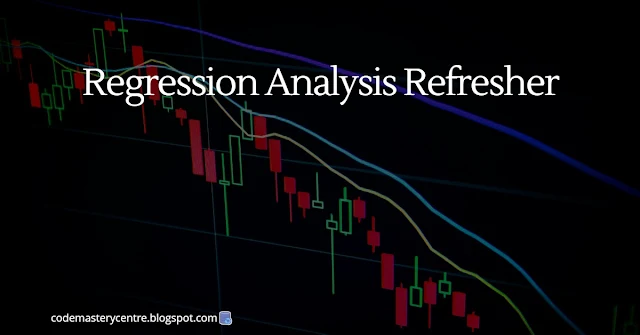Regression Analysis Refresher
Understanding Regression Analysis
Regression analysis is a statistical method used to explore the relationships between independent and dependent variables. Its main objectives include understanding these relationships, predicting outcomes, and identifying key variables that influence results.
In the realm of predictive modeling, regression analysis is invaluable. It equips businesses with the ability to forecast future outcomes by evaluating historical data. This predictive power is crucial for strategic decisions, such as estimating future sales or customer satisfaction levels.
Central to regression analysis are the concepts of dependent and independent variables. The dependent variable is the outcome being predicted, while the independent variables are factors that potentially influence this outcome. Understanding these components is essential for conducting effective regression analysis and deriving actionable insights.
How Regression Analysis Works
Regression analysis is a cornerstone of predictive modeling, designed to unravel the relationships between dependent and independent variables. Among the various techniques, linear regression, logistic regression, and polynomial regression stand out. Each technique serves a unique purpose, from handling binary outcomes to addressing nonlinear relationships.
At the heart of regression analysis lies the application of statistical methods. These methods are crucial for accurately analyzing data and interpreting complex relationships. Statistical software aids in plotting data and calculating regression lines, ensuring that the analysis is both visual and precise.
To conduct a regression analysis, start by defining your dependent and independent variables, ensuring data is collected systematically. Next, plot the data to visualize potential relationships. Choose the appropriate regression model, execute the analysis using statistical software, and interpret the results. Finally, verify assumptions like linearity and independence to refine the model. By following these steps, regression analysis becomes a powerful tool for predicting outcomes and making informed decisions.
Practical Applications in Business
Regression analysis is a versatile tool employed across various industries to predict outcomes and understand the intricate relationships between variables. In the financial industry, it is pivotal for tasks like estimating house or stock prices, offering insights into factors impacting financial outcomes. The retail sector also benefits significantly, using regression to forecast sales and optimize marketing strategies by analyzing past sales data and advertising spend.
In the automobile industry, regression analysis enhances vehicle safety and performance understanding, while weather analysis uses it to predict future conditions. The gaming industry leverages regression to analyze player behavior, informing game design improvements to boost engagement and retention.
Beyond industry-specific applications, regression analysis offers universal benefits for businesses. It facilitates data-driven decisions, helping companies identify key factors that influence outcomes and optimize resource allocation. For instance, understanding the correlation between marketing efforts and sales success can guide strategic hiring decisions, enhancing overall effectiveness and performance metrics.
Ultimately, regression analysis empowers businesses to make informed decisions, optimize operations, and achieve more accurate forecasting, driving growth and efficiency across diverse sectors.
Best Practices for Conducting Regression Analysis
Conducting an accurate regression analysis begins with ensuring data quality. Address missing values, outliers, and redundancy to maintain integrity. Techniques like imputation and outlier detection can significantly enhance your dataset, reducing noise and high dimensionality to improve model performance.
Choosing the right model is crucial. Aim for a balance between simplicity and complexity. A model should include relevant predictors to avoid bias without overcomplicating the analysis. Utilize statistical measures such as adjusted R-squared and p-values to guide your selection, ensuring precision and unbiased estimates.
Interpreting results accurately is key to deriving actionable insights. Understand the variation explained by your model versus unexplained variation through tools like the ANOVA table. Pay attention to confidence and prediction intervals to quantify uncertainty in predictions. Additionally, ensure that your slope coefficients indicate a significant relationship, supported by R² values to assess model fit.
By following these best practices, you can conduct regression analysis that not only predicts outcomes but also drives strategic decision-making with confidence.
FAQ on Regression Analysis
1. What Are Assumptions of Linear Regression?
Linear regression is based on four key assumptions: linearity, independence, normality, and homoscedasticity. These ensure a linear relationship exists between variables, residuals are normally distributed, and data points have consistent variance.
2. What is a Residual?
A residual is the difference between observed and predicted values in a regression model. They help assess model fit, revealing patterns that may indicate assumption violations.
3. What Are Dependent and Independent Variables?
The dependent variable is what you aim to predict, like sales figures. Independent variables are factors that influence it, such as marketing efforts or pricing changes.
4. How Do You Choose Between Simple and Multiple Regression?
Opt for simple linear regression when dealing with one predictor. Use multiple regression for complex models with several predictors to capture more intricate relationships.
Understanding these concepts enhances your ability to conduct effective regression analysis, paving the way for more accurate predictions and strategic insights.
Conclusion
In this refresher on regression analysis, we've navigated through its fundamental components, from understanding dependent and independent variables to exploring different types of regression techniques. We also highlighted critical assumptions like linearity and homoscedasticity, which ensure the integrity of analysis.
Regression analysis remains a cornerstone in data analytics, transforming raw data into actionable insights. Its predictive power and capacity to uncover relationships make it indispensable for informed decision-making in any industry. Understanding these core elements equips analysts to harness its full potential effectively.






